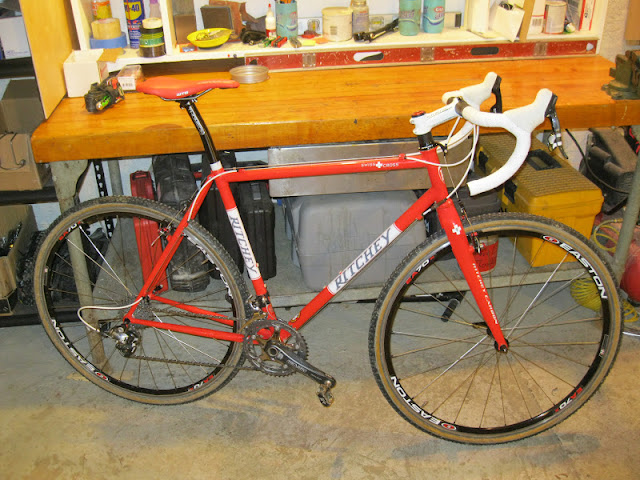
With a handful of rides and a race on my new Ritchey Swiss Cross I can offer some informed feedback.
The bike has classic lines and simple panel paint scheme consistent with its heritage as a race bike. Several companies offer steel cross bikes, but few outside of boutique builders Zanconato and Richard Sachs offer a true steel race bike.
I hadn't ridden a cross bike since last year's Gravel Grinder but I have to say the Ritchey handles more like a mountain bike than any other cross bike I've ridden. Switching over to this felt very natural and predictable, which shouldn't be a surprise given Ritchey's experience building cross bikes for mountain bike racers.
There's still a skinnier tire learning curve after spending so much time on mountain bikes, but the bike a great blend of smooth ride feel and predictable handling. My first impression was how well the bike matched my expectations right out of the box.
One of the updates from the original is the integrated bearing cups. It's a small thing that adds a modern touch and saves some weight in the process.
There's no frame mounted barrel adjuster for the front derailleur so you need to run one in-line.
Fortunately this frame is devoid of rack and fender mounts but does have bottle mounts. You can easily use the stock bottle bolts to fill the mounting holes but I prefer to use nylon bolts cut to length. They cost about $.70 each at the hardware store and not only do a great job of sealing out moisture but also look really pro.
Ritchey socket dropouts were the standard for high quality production steel bikes. Like most steel frames the derailleur hanger is dedicated and can be worked back into position rather than replaced.
Since I've owned many steel bikes before I was ready for the build-related nuances of a the smaller front derailleur clamp, rear brake cable routing and need to apply a rust preventative treatment as soon as it was out of the box. The Swiss Cross is offered as frameset with fork and headset only so I used a SRAM Force cross
build kit, a WCS bar and stem and some other parts I had kicking around
to complete the build. Total weight right now as pictured is 19 lbs flat including Shimano XT pedals.
With those small but important details in mind the only real assembly related hiccup was an excess of paint in the threads of the derailleur hanger. The alloy mounting bolt on the Force derailleur would not start on its own so I chased the threads with a derailleur hanger straightening tool although I suppose any steel derailleur mounting bolt would work as well.
My taste in bikes is pretty consistent- I like high quality metal bikes
with legitimate race cred and stable handling, so for me the Swiss Cross
is a perfect fit.
















.JPG)












.JPG)